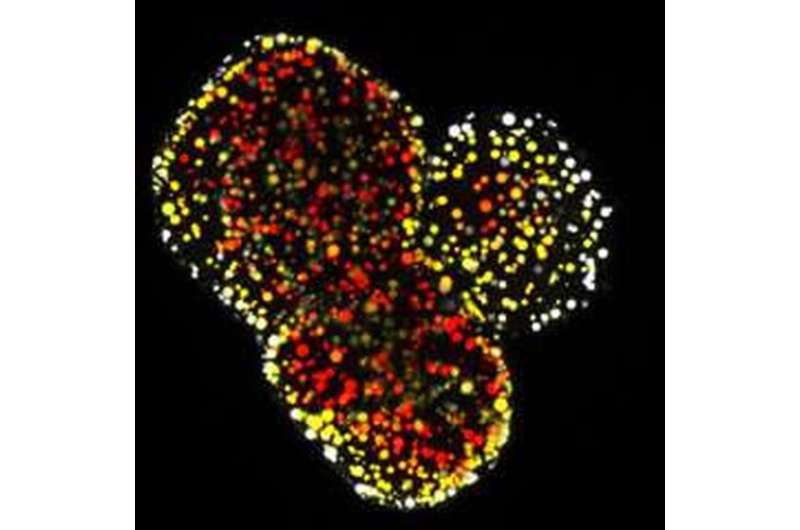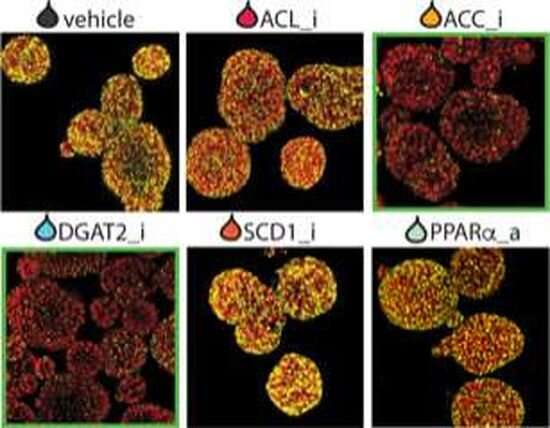This article has been reviewed according to Science X's editorial process and policies. Editors have highlighted the following attributes while ensuring the content's credibility:
fact-checked
peer-reviewed publication
trusted source
proofread
Novel organoid models to study non-alcoholic fatty liver disease

Researchers from the Organoid group (former Clevers group, Hubrecht Institute) together with researchers from the Princess Máxima Center for pediatric oncology have established novel human organoid models of fatty liver disease. They used these models to shed light on drug responses, and established a CRISPR-screening platform to identify novel disease mediators and potential therapeutic targets.
These models will aid in testing and developing novel medicines to treat fatty liver disease and help facilitate a better understanding of the disease biology. The results of the study are published in Nature Biotechnology on February 23, 2023.
The buildup of fat in the liver is an increasingly common disease worldwide, with over a quarter of the worldwide population affected. Having a fatty liver can lead to inflammation, impairment of liver function, and eventually result in scar tissue formation. Different causes can lead to the development of fatty liver, with diet and lifestyle being the most common contributors. Moreover, genetics can play an important role. For example, genetic lipid disorders make patients more likely to develop fatty liver disease and several mutations heighten the risk to develop the disease.
No therapy
Worryingly, no treatment for fatty liver currently exists that can halt or revert the disease. As the disease progresses, the risk of irreversible liver damage and the need for liver transplantation greatly increases. In addition, individuals with fatty liver are at heightened risk to develop liver cancer. Identifying ways to tackle the disease is challenging due to the scarcity of model systems.
Mice differ greatly in their metabolism and can therefore not be used as a representative model system of the human disease. Moreover, current human-based in vitro models possess several drawbacks. Genetic modification of these models is difficult and it is currently impossible to quickly generate large numbers of cells.
Fatty liver organoids
Now, the researchers have turned to organoids to establish three models that capture different triggers of fatty liver development. Firstly, they fed the organoids with a mixture of fatty acids to mimic a Western diet and witnessed the rapid development of fatty liver organoids.
As a second model, the team introduced the top risk mutation for fatty liver disease into their organoid system using a new CRISPR tool named prime editing. Organoids with this mutation displayed much more severe fat accumulation than organoids without it.
Finally, the researchers also modeled genetic lipid disorders using CRISPR-Cas9 to investigate how these disorders influence the development of fatty liver disease. These mutant organoids spontaneously developed severe fatty livers as a result of a build-up of sugar-derived fats.

Discovery of novel drug targets
The team then screened a large number of drug candidates to treat fatty liver disease on the newly developed organoid models. Interestingly, the researchers observed that the different fatty liver organoid models responded to the drugs in a very comparable manner. They thus were able to identify a subset of drugs that was effective across all models.
Interestingly, these effective drugs functioned through a common mechanism in which the generation of lipids from sugars was blocked. The team also observed that organoids having the top risk mutation for fatty liver disease did not react to all drugs in the same way as organoids without the mutation. This shows the organoids can be used as a tool for personalized medicine.
CRISPR platform
The researchers went on to use their organoid models to establish a genetic screening platform to identify novel genes with roles in fatty liver disease. The researchers turned their organoids into a CRISPR-screening platform, named FatTracer. They used this platform to investigate the effect of loss of specific genes on the fatty liver phenotype, which could be visualized in real-time over 20 days.
After screening 35 candidates, a novel and critical role for the FADS2 gene (fatty acid desaturase 2) in fatty liver disease was discovered. Disruption of FADS2 made the organoids much more fatty. The team wondered whether the opposite condition, having more FADS2, would instead be beneficial to the disease. Indeed, when overexpressing FADS2, the fatty liver that the organoids once displayed was severely reduced, suggesting it is a potential novel therapeutic target.
These novel fatty liver organoid models pave the way for many future studies. For example, the researchers would like to better understand the genetic risks that are linked to the development of fatty liver, as well as to study what factors influence disease progression. The ultimate aim is to use these models to define (personalized) drug therapies that can cure the liver from fat overload.
More information: Delilah Hendriks, Engineered human hepatocyte organoids enable CRISPR-based target discovery and drug screening for steatosis, Nature Biotechnology (2023). DOI: 10.1038/s41587-023-01680-4. www.nature.com/articles/s41587-023-01680-4


















